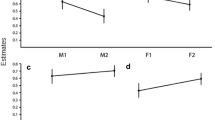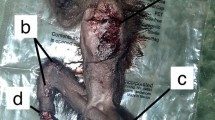Abstract
I review literature on juvenile mortality of captive prosimians in order to evaluate the available information on captive breeding. Juvenile mortality includes abortion, premature mortality, stillbirth, and death of the unweaned young. Prosimian juvenile mortality ranges between 25 and 45% in captive populations. It is generally lower in the Lemuroidea, particularly the Cheirogaleidae, than in the Lorisoidea. Mortality is particularly high in the Lorisinae. Most mortality, including a high stillbirth rate, occurs on the first day and during the first 10 days thereafter. Stress, maternal neglect and traumatic insults, not infrequently linked to each other, are the most frequently reported causes of death. The percentage of congenital malformations tends to be high in some colonies. Sex of the infant and parity seem to be important risk factors for juvenile mortality, whereas litter size does not appear to be important. Based on few data, wild- caught females appear to have higher breeding success than those born in captivity. Synchronized births in lemuroids and isolated births in Galagoare more likely to result in successfully weaned infants.
Similar content being viewed by others
References
Benirschke, K. (1980). Pectus excavatum in ruffed lemurs(Lemur variegatus).Proc. Int. Symp. Erkrank. Zoo Wildtiere 22: 169–172.
Benirschke, K., Kumamoto, A. T., and Bogart, M. H. (1981a). Congenital anomalies inLemur variegatus.J. Med. Primatol. 10: 38–45.
Benirschke, K., and Miller, C. J. (1981b). Weights and neonatal growth of ring-tailed lemurs(Lemur catta) and ruffed lemurs(Lemur variegatus).J. Zoo Anim. Med. 12: 107–111.
Brockman, D. K., Willis, M. S., and Karesh, W. B. (1987). Management and husbandry of ruffed lemurs,Varecia variegata, at the San Diego Zoo. II. Reproduction, pregnancy, parturition, litter size, infant care and reintroduction of hand raised infants.Zoo Biol. 6: 349–363.
Brockman, D. K., Willis, M. S., and Karesh, W. B. (1988). Management and husbandry of ruffed lemurs,Varecia variegata, at the San Diego Zoo. III. Medical considerations and population management.Zoo Biol. 7: 253–262.
de Boer, L. E. M. (1989). Genetics and breeding programmes (genetic guidelines and their backgrounds).EEP Coordinators Manual, May 1989 Version (National Foundation of Research in Zoological Gardens, c/o Amsterdam Zoo, P.O. Box 20164, 1000 HD Amsterdam, The Netherlands).
Glatston, A. R. (1981). The husbandry, breeding and hand rearing of the lesser mouse lemur(Microcebus murinus) at Rotterdam Zoo.Int. Zoo Yb. 21: 131–137.
Glatston, A. R. (1984). The influence on maternal behaviour and breeding success in the lesser mouse lemur(Microcebus murinus). In Else and Lee (eds.),Primate Ontogeny, Cognition and Social Behaviour, Proceedings of the 10th Congress of the International Primatological Society, Vol 3, Cambridge University Press, Cambridge, pp. 355–361.
Grassé, P. P. (1955).Traité de Zoologie. Anatomie, Systématique, Biologie des mammifères, Masson et Cie, Paris, Tome XVII, Fasc. II, pp. 1854–2206.
Harvey, P. H., and Clutton-Brock, T. H. (1985). Life history variation in primates.Evolution 39 (3): 559–581.
Hendrickx, A. G., and Newman, L. M. (1978). Reproduction of the greater bushbaby(Galago crassicaudatus panganiensis) under laboratory conditions.J. Med. Primatol. 7: 26–43.
Honacki, J. H., Kinman, K. E., and Koeppl, J. W. (1982).Mammal Species of the World. A Taxonomic and Geographic Reference, Allen Press and Association of Systematics Collections, Lawrence, KS, pp. 216–222.
Izard, M. K., and Simons, E. L. (1986a). Infant survival and litter size in primigravid and multigravid Galagos.J. Med. Primatol. 15: 27–35.
Izard, M. K., and Simons, E. L. (1986b). Isolation of females prior to parturition reduces neonatal mortality inGalago.Am. J. PrimatoL 10: 249–255.
Izard, M. K., and Simons, E. L. (1987). Lactation and interbirth interval in the Senegal galago(Galago senegalensis moholi).J. Med. Primatol. 16: 232–332.
Jolly, A. (1973). Primate birth hour.Int. Zoo Yb. 13: 391–397.
King, N. E., and Mitchell, G. (1987). Breeding primates in zoos. In Mitchell, G., and Erwin, J. (eds.),Comparative Primate Biology, Vol. II. Behavior, Cognition and Motivation, Alan R. Liss, pp. 219–261.
Lindburg, D. G., Berkson, J. M., and Nightenhelser, L. K. (1984). Primate breeding in zoos: A ten-year summary. In Ryder, O. A., and Byrd, M. L. (eds.),One Medicine, Springer-Verlag, Berlin, pp. 163–170.
Nowak, R. M., and Paradiso, J. L. (eds.) (1983).Walker's Mammals of the World, 4th ed., John Hopkins University Press, Baltimore, Vol. 1, pp. 393–479.
Olney, P. J. S. (ed.) (1982). Species of wild animals bred in captivity and multiple generations births in 1980.Int. Zoo Yb. 22: 409–416.
Olney, P. J. S. (ed.) (1983). Species of wild animals bred in captivity and multiple generations births 1981.Int. Zoo Yb. 23: 311–318.
Olney, P. J. S. (ed.) (1986a). Species of wild animals bred in captivity and multiple generations births 1982/1983.Int. Zoo Yb. 24/25: 511–524.
Olney, P. J. S. (ed.) (1986b). Species of wild animals bred in captivity and multiple generations births 1984.Int. Zoo Yb. 26: 471–480.
Olney, P. J. S. (ed.) (1987). Species of wild animals bred in captivity and multiple generations births 1985.Int. Zoo Yb. 27: 399–408.
Olney, P. J. S. (ed.) (1988). Species of wild animals bred in captivity and multiple generations births 1986.Int. Zoo Yb. 28: 449–459.
Olney, P. J. S. (ed.) (1989). Species of wild animals bred in captivity and multiple generations births 1987.Int. Zoo Yb. 29: 310–320.
Olney, P. J. S. (ed.) (1990). Species of wild animals bred in captivity and multiple generations births 1988/89.Int. Zoo Yb. 30: 427–443.
Packer, C. (1979). Inter-troop transfer and inbreeding avoidance inPapio anubis.Anim. Behav. 27: 1–36.
Perry, J. M., Izard, M. K., and Fail, P. A. (1992). Observations on reproduction, hormones, copulatory behavior, and neonatal mortality in captiveLemur mongoz (mongoose lemur).Zoo Biol. 11: 81–97.
Petter, J. J. (1975). Breeding of malagasy lemurs in captivity. In Martin, R. D. (ed.),Breeding Endangered Species in Captivity, Academic Press, London, pp. 188–202.
Pollock, J. (1986). Litter size, sex ratio, mortality and parity inVarecia variegata.Primate Rep. Göttingen, 14: 65–66.
Prescott, J. (1980). Breeding the brown lemur(Lemur macaco fulvus) at the Quebec Zoo.Int. Zoo Yb. 20: 215–218.
Rails, K., and Ballou, J. (1982). Effects of inbreeding on infant mortality in captive primates.Int. J. Primatol. 3(4): 491–505.
Rails, K., and Ballou, J. (1983). Extinction: Lessons from zoos. In Schonewald Cox, C. M., Chambers, S. M., MacBryde, B., and Thomas, W. L. (eds.),Genetics and Conservation, Benjamin/Cummings, London, pp. 164–185.
Richard, A. F. (ed.) (1985). Chapter VI: Reproduction. InPrimates in Nature, W. H. Freeman, New York.
Schaaf, C. D., and Stuart, M. D. (1983). Reproduction of the mongoose lemur(Lemur mongoz) in captivity.Zoo Biol. 2: 23–38.
Shideler, S. E., and Lindburg, D. G. (1982). Selected aspects ofLemur variegatus reproductive biology.Zoo Biol. 1: 127–134.
Smuts, B. B., Cheney, D. L., Seyfarth, R. M., Wrangham, R. W., and Struhsaker, Th. T. (eds.) (1987),Primate Societies, University of Chicago Press, Chicago, pp. 502–505.
Tartabini, A. (1991). Mother-infant cannibalism in thick-tailed bushbabies(Galago crassicaudatus umbrosus).Primates 32(3): 379–383.
van Schaik, C. P., and de Visser, J. A. G. M. (1990). Fragile sons or harassed daughters? Sex differences in mortality among juvenile primates.Folia Primatol. 55: 10–23.
Author information
Authors and Affiliations
Rights and permissions
About this article
Cite this article
Debyser, I.W.J. Prosimian juvenile mortality in zoos and primate centers. International Journal of Primatology 16, 889–907 (1995). https://doi.org/10.1007/BF02696109
Received:
Accepted:
Issue Date:
DOI: https://doi.org/10.1007/BF02696109




